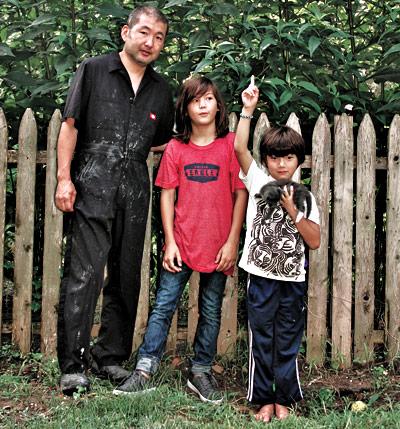More Than Tubers in Hiroyuki’s Garden

My husband planted Jerusalem artichokes in his East Hampton vegetable garden last fall. He ordered them from an online catalog that a friend had recommended. They looked like pieces of ginger root — that light brown color and that gnarled shape. My husband made an area for them along the north side of the garden fence, and then he planted the tubers about three inches down in the ground. He installed a mesh barrier about six inches deep around the area to prevent underground traveling creatures from eating the tubers. And that was it.
Then, he let the Jerusalem artichokes do their thing down there in the earth. Harvesting and eating wasn’t going to come around till much later — another whole year.
There’s a lot of “my husband” and “he” in the planting of the Jerusalem artichokes because the garden is his domain, a habitat of his own creation, in which he is comfortable and patient. He does all the masterminding, planting, and nurturing. To grow anything at all is very wonderful and impressive to someone like me, with a brownish-black thumb and a self-defeating attitude on things like remembering to water. How can I hope to grow anything — ever — a pea or a bean or a pepper (or a better attitude), when the whole process towers as a totally impossible feat? So I’m generally admiring of my husband’s vegetable garden without too much of a specific focus on details. Meaning, without too much of a focus on the actual plants. I like that they’re there, but someone else is the someone giving the plants the attention they need, and so, un-needed on that one, I turn to other needy areas of our life.
With the Jerusalem artichokes, however, it was different. I started watching because I became fascinated by how fast and strong the plants were coming up, how totally vital the visible stalks were — vital and visible and reaching up as the tubers kept mysteriously hidden below. It was hard to miss them, hard not to get curious. “Look boys,” I said to my kids back in the spring, “those are the Jerusalem artichokes your dad planted. Look how fast they’re growing.”
Around the end of June, the above-ground stalks of the plants had become about four feet high. They were strong and straight with deep green, delicately pointy, slightly sticky leaves. And they kept on growing. Strong, straight, and deeply green-leaved, they kept it up, passing five, seven, nine feet tall.
As the summer progressed, buds appeared way up at the top, and since even I knew that the part of the plant you eat is the tuber, and that the tubers are underground, I knew it to be true when my husband said flowers would be coming. I looked every day thinking surely, it’s late July — aren’t the flowers coming yet? But they weren’t. The stalks kept going, strong, straight, and deeply green-leaved as ever they had grown themselves to be, past 10 feet to 11 or 12, the tallest even taller.
“Look boys, the Jerusalem artichokes are really growing like crazy,” I said, pointing out the very obvious to a nonetheless receptive audience. After all, what we were seeing was impressive. And then, as August came, and I turned the calendar over, and said not a word to my summer-enthralled children but knew in my grown-up heart that August means summer can do nothing but end, I started thinking maybe the flowers would never really come. Maybe the buds, which looked shapely but firmly closed, would not open after all. I think I was trying to shield myself from disappointment. It’s hard to care about something you can’t control.
But at the beginning of September, after Labor Day, at the end of that rainy rainy week (remember it?), just as the boys were overtaken by the blend of anticipation/anxiety/bummer/curiosity that is their collective back-to-school feeling (plus squeezing their feet into shoes, unknown all summer), the Jerusalem artichoke flowers began to bloom. They were very modest at first, just opening, yellow sunflower type blooms, bobbing up at the top of those super-tall stalks, starting to nod hello to the sun. But as the week progressed, they opened in bright yellow profusion, the flowers surprisingly delicate, the leaves pointy, the centers yellowy brown.
By mid-September, there were lots and lots of flowers, not just at the top but starting from about halfway up the stalks (always looking up, I hadn’t noticed those buds). They waved in the wind and winked in the sun, and I felt totally confronted with the strength of the life of those beautiful stalks and schooled by the perfect progression with which they were living it.
I had thought the Jerusalem artichoke flowers would be pretty and satisfying, but I didn’t know they would be glorious. And neither did my husband, even as he was the planter and the grower and the mastermind of the vegetable garden. We didn’t know the actuality of the joy the flowers would bring, the delight. And the story isn’t half told! There’s still the harvesting and the cooking and the eating of the Jerusalem artichokes. I’m expecting them to be good — earthy and satisfying — but who knows what glories I don’t yet know, haven’t imagined, that lie developing in the Jerusalem artichokes.
Meanwhile, my husband says that we should cut the flowers so that the tubers will grow bigger and better. How I can ever bear to do this, or watch him do it, I don’t know. How to sacrifice the splendor of them, even for growth? But a cut flower bouquet put in a coffee can container and left at a friend’s back door as an early fall gift is the perfect solution for a situation like this. Outside to inside; our habitat to yours, a stage in the story of those Jerusalem artichokes.
